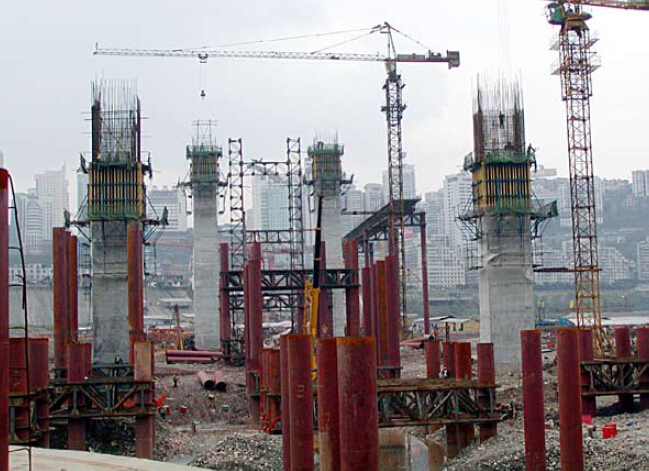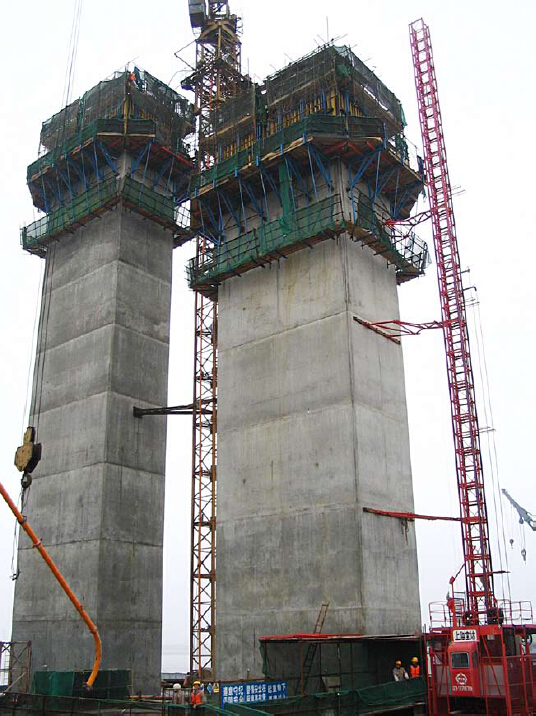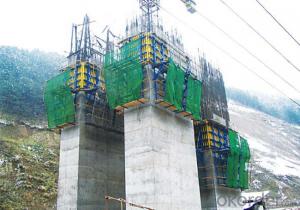Climbing bracket CB240 for formwork and scaffolding systems
- Loading Port:
- Tianjin
- Payment Terms:
- TT OR LC
- Min Order Qty:
- 50 m²
- Supply Capability:
- 1000 m²/month
OKorder Service Pledge
OKorder Financial Service
You Might Also Like
Climbing Bracket CB240 & CB210
They are framework brackets for supporting large-area wall formwork.
Typical applications for the CB240&CB210 are pier and column/shear wall/core walll/ in the
building.
CB210 has smaller size than CB240, it will be cost effective in some condition.
Characteristics:
◆ High bearing capacity
The high loading capacity of the brackets allow very large scaffold units. This saves the number
anchor points required as well as reducing climbing times.
◆ Simple moving procedure by crane
Through the strong connection of formwork together with the climbing scaffold, both can be moved
as a single climbing unit by crane. Thus valuable time-savings can be achieved.
◆ Fast striking process without a crane
With the retrusive set, large formwork elements can also be retracted quickly and a minimum of
effort.
◆ Safe with work platform
The platforms have assembled firmly with bracket and will be climbing together, without scaffolding
but can work safely in spite of your high location.


- Q:Can steel formwork be used for structures with high thermal insulation requirements?
- Structures that require high thermal insulation typically do not employ steel formwork. This is due to steel's high heat conductivity, which facilitates heat transfer. Consequently, using steel formwork in such structures would result in significant heat loss and reduce the building's overall energy efficiency. To achieve optimal thermal insulation, materials with excellent thermal resistance, such as insulating concrete forms (ICFs), expanded polystyrene (EPS), or other insulated formwork systems, are preferred. These materials possess low thermal conductivity and serve as barriers against heat transfer. By utilizing these materials, structures can fulfill the demanding thermal insulation requirements and enhance energy efficiency. Nevertheless, it is important to note that steel formwork can still be utilized in conjunction with insulation materials to provide structural support and shape the structure. In this scenario, additional insulation measures, such as the application of insulation layers or the utilization of insulation inserts, would be necessary to augment the thermal performance of the structure. In conclusion, while steel formwork may be suitable for various construction projects, it is not the optimal choice for structures that necessitate high thermal insulation.
- Q:Steel formwork in the construction project, after the completion of concrete pouring, the wall surface from the powder seriously how to deal with?
- This is no problem with the steel template, the ratio of concrete problems!
- Q:How does steel formwork contribute to the overall constructability of complex structures?
- In enhancing the overall constructability of complex structures, steel formwork plays a crucial role through various means. Firstly, it provides exceptional strength and durability, enabling it to withstand the heavy loads and pressures exerted during construction. This sturdiness ensures the stability and safety of the structure, minimizing the risk of collapse or failure. Furthermore, steel formwork offers immense flexibility and versatility in shaping different architectural elements, allowing for the construction of intricate and complex designs. Its ability to be easily customized and adjusted facilitates the creation of unique and aesthetically pleasing structures. Moreover, compared to traditional formwork systems, steel formwork enhances construction efficiency by enabling faster assembly and disassembly. The ease of installation and removal reduces construction time, resulting in significant cost savings and increased productivity. Additionally, the reusable nature of steel formwork allows for multiple applications, making it a cost-effective choice in the long run. In addition, steel formwork is highly resistant to moisture, chemicals, and extreme weather conditions, ensuring its longevity and minimizing maintenance requirements. This durability makes it particularly suitable for complex structures where long-term reliability is essential. Overall, steel formwork contributes to the overall constructability of complex structures by providing strength, flexibility, efficiency, and durability. Its ability to withstand heavy loads, create intricate designs, and expedite the construction process makes it an invaluable tool in successfully realizing complex architectural projects.
- Q:Can steel formwork be used in combination with other types of formwork?
- Combining different types of formwork is a common practice in construction projects to meet specific structural requirements. Steel formwork offers advantages such as durability, reusability, and high load-carrying capacity, making it suitable for large-scale or complex projects. However, it can be costly and heavier compared to other options. To achieve speed and efficiency, contractors may opt for a combination of steel formwork with timber or aluminum. Timber formwork can be used for simpler sections with lighter loads, reducing costs and improving overall efficiency. Steel formwork, on the other hand, is ideal for critical areas with higher load requirements or complex shapes. This combination allows for flexibility in design and construction methods, optimizing resource utilization and minimizing costs. However, proper coordination and planning are crucial to ensure compatibility and support among the different formwork types, maintaining structural integrity. Safety measures should also be implemented to protect workers during the construction process. In conclusion, steel formwork can be effectively combined with other types to achieve construction goals, improve efficiency, and optimize resource utilization.
- Q:Can steel formwork be customized for specific project requirements?
- Yes, steel formwork can be customized for specific project requirements. Steel is a highly versatile material that can be easily molded and shaped according to the specific needs of a project. This allows for the creation of various sizes, shapes, and designs to accommodate different construction requirements. Steel formwork can be easily modified or adjusted on-site to meet the specific dimensions and specifications of a project. Additionally, steel formwork can also be pre-fabricated off-site, where it can be tailored to the exact requirements of the project before being transported to the construction site. This customization of steel formwork ensures that it can be effectively used in a wide range of construction projects, including complex structures, high-rise buildings, bridges, tunnels, and more.
- Q:What are the typical environmental considerations when using steel formwork?
- Some typical environmental considerations when using steel formwork include the impact of steel production on carbon emissions, the potential for steel to be recycled and reused, the use of non-toxic coatings and sealants to minimize environmental pollution, and the proper disposal or recycling of steel formwork at the end of its lifespan.
- Q:What are the different types of accessories used in steel formwork installation?
- There are several types of accessories used in steel formwork installation, including form ties, wedges, clamps, spreaders, and braces. These accessories help secure and stabilize the formwork system, ensuring that the concrete is poured and set properly.
- Q:What are the different types of alignment systems used with steel formwork?
- There are several different types of alignment systems that are commonly used with steel formwork in construction projects. These alignment systems serve to ensure that the formwork is properly aligned and positioned, allowing for accurate and precise concrete placement. 1. Pin and wedge system: This is one of the most widely used alignment systems with steel formwork. It involves the use of steel pins, which are inserted into pre-drilled holes in the formwork panels, and wedges that are driven into the pins to secure the panels together. This system provides a strong and reliable connection, allowing for precise alignment. 2. Flat tie system: This alignment system uses flat ties, which are inserted through the formwork panels and secured using various methods such as nuts and washers or locking pins. The flat ties provide stability and alignment by connecting the formwork panels together. 3. Adjustable clamp system: This system utilizes adjustable clamps that are attached to the formwork panels. The clamps can be adjusted to achieve the desired alignment and are tightened to hold the panels in place. This system offers flexibility and ease of adjustment during the formwork installation process. 4. Strut and prop system: This alignment system involves the use of vertical struts and props to support and align the formwork panels. The struts are connected to the formwork panels and the props are used to adjust the height and alignment. This system is particularly useful for large or complex formwork structures. 5. Magnetic alignment system: This is a relatively new alignment system that utilizes magnets to hold the formwork panels together. The magnets are embedded in the formwork panels, allowing for quick and easy alignment without the need for additional tools or fasteners. This system offers convenience and speed in formwork installation. Overall, the choice of alignment system depends on factors such as the size and complexity of the formwork structure, the required level of precision, and the specific requirements of the construction project. Contractors and engineers select the most appropriate alignment system based on these considerations to ensure the successful installation and alignment of steel formwork.
- Q:Is steel formwork suitable for projects with high architectural demands?
- Projects with high architectural demands can benefit greatly from the use of steel formwork. The durability of steel formwork enables it to withstand the pressures and forces experienced during construction, ensuring that it maintains its shape and integrity. As a result, precise and accurate concrete structures can be achieved. In addition to its durability, steel formwork offers versatility and customization options to meet specific architectural requirements. It can easily be shaped and designed to create intricate and unique structures, making it ideal for projects that require complex architectural elements. Furthermore, the use of steel formwork results in high-quality finishes on concrete surfaces. The smooth and uniform surfaces created by steel formwork reduce the need for additional finishing work. This is particularly important for projects with high architectural demands, where attention to detail and aesthetic appeal are crucial. Moreover, steel formwork provides excellent strength and stability, ensuring that concrete structures maintain their shape and remain intact over time. This is especially important in projects with high architectural demands, where structural integrity is of utmost importance. In summary, steel formwork is a suitable choice for projects with high architectural demands due to its durability, versatility, high-quality finish, and strength. It allows for the creation of visually appealing structures while ensuring long-term performance and structural integrity.
- Q:How does steel formwork contribute to the overall fire safety of the building?
- Steel formwork can contribute significantly to the overall fire safety of a building due to its inherent properties and characteristics. Firstly, steel formwork is known for its high fire resistance. Steel has a high melting point and does not ignite or burn easily, making it a suitable material for construction in areas prone to fire hazards. In the event of a fire, steel formwork remains structurally stable, providing a crucial barrier that helps to contain the fire and prevent its spread to other parts of the building. This can be especially important in high-rise buildings, where fire safety is of utmost importance. Additionally, steel formwork is non-combustible, meaning it does not release flammable gases or toxic fumes when exposed to fire. This is crucial for the safety of occupants, as smoke inhalation and toxic gases are significant causes of casualties in fire incidents. By using steel formwork, the risk of smoke and toxic gases spreading throughout the building is minimized, allowing occupants more time to evacuate safely. Moreover, steel formwork is a durable and robust material, capable of withstanding the impact of fire and retaining its structural integrity. This is crucial in ensuring the stability of the building during a fire, as it prevents collapse and reduces the risk of injuries or fatalities. Steel formwork can also resist the effects of high temperatures, such as thermal expansion, which can further contribute to the fire safety of the building. In conclusion, steel formwork plays a vital role in enhancing the overall fire safety of a building. Its high fire resistance, non-combustible nature, and durability contribute to containing fires, minimizing the spread of smoke and toxic gases, and maintaining the structural integrity of the building. By incorporating steel formwork in construction, the risk of fire-related incidents and the potential consequences can be significantly reduced, ensuring the safety of occupants and property.
1. Manufacturer Overview |
|
|---|---|
| Location | |
| Year Established | |
| Annual Output Value | |
| Main Markets | |
| Company Certifications | |
2. Manufacturer Certificates |
|
|---|---|
| a) Certification Name | |
| Range | |
| Reference | |
| Validity Period | |
3. Manufacturer Capability |
|
|---|---|
| a)Trade Capacity | |
| Nearest Port | |
| Export Percentage | |
| No.of Employees in Trade Department | |
| Language Spoken: | |
| b)Factory Information | |
| Factory Size: | |
| No. of Production Lines | |
| Contract Manufacturing | |
| Product Price Range | |
Send your message to us
Climbing bracket CB240 for formwork and scaffolding systems
- Loading Port:
- Tianjin
- Payment Terms:
- TT OR LC
- Min Order Qty:
- 50 m²
- Supply Capability:
- 1000 m²/month
OKorder Service Pledge
OKorder Financial Service
Similar products
New products
Hot products























